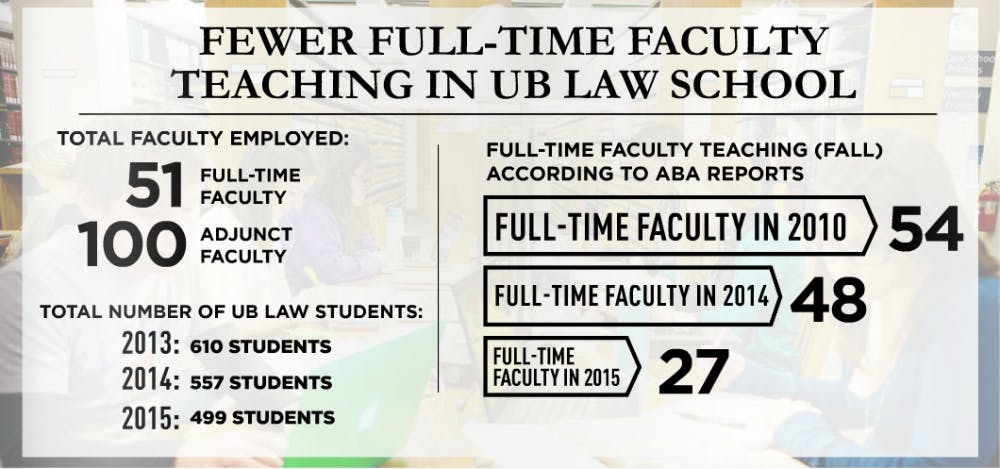Since 2010, the UB Law School has dropped its number of full-time faculty actively teaching so significantly that it ranks among the top national law school statistics.
UB’s law school went from having 54 full-time faculty members teaching in the fall of 2010 to just 27 last fall, according to the American Bar Association’s annual 509 information reports. That includes a drop off from 48 full-time faculty members who taught in the fall of 2014.
UB’s decrease is among the top 10 largest net decreases in the country, according to Matt Leichter of legal education blog site The Last Gen X American, who compiled the ABA data of law schools across the country. The report shows that UB’s law school is far from alone, as it is one of 21 other law schools that have had a net decrease of 20 or more in teaching full-time faculty members since 2010.
James Gardner, interim dean of the law school, said the ABA statistics are misleading and questions how they are collected, as the ABA data only shows how many full-time faculty members are currently teaching, not how many are actually employed with the law school.
Although just 27 were actually teaching last fall, Gardner says there are currently 51 full-time faculty members employed within UB’s law school. UB’s ABA report shows the law school had an additional 37 faculty members teaching part-time in the fall of 2015.
“[The ABA] does not ask how many faculty [members] are actually employed, but how many are actually teaching full-time at the precise moment of the snapshot,” Gardner said in an email. “Thus, the ABA excludes from the calculation any faculty who are on leave or sabbatical, even though these faculty remain full-time employees and are entitled to leave or sabbatical only once in a great while.”
Still, this would leave a large number of full-time law faculty employed by the law school but not teaching due being on leave or sabbatical.
He also adds that the ABA has a strict definition of what a full-time faculty member is, as the ABA does not consider faculty with administrative responsibilities full-time.
Liechter defends the report and the ABA data, saying the only way to acquire data regarding full-time law school faculty members is from the ABA’s report, since most schools do not publicly announce when a full-time faculty member is let go or retires.
According to a faculty member in the law school who wished to remain anonymous, former Dean Makau Mutua made hiring faculty a priority and during his administration the law school greatly increased in size with the hiring of 18 current full-time faculty from 2007-14.
In 2013, Mutua offered retirement incentives in order to decrease tenured faculty, which resulted in eight faculty members retiring, the professor said. Gardner has also offered retirement incentives to tenured faculty in the law school during his time as interim dean.
The professor said a decrease in enrollment rates may have resulted in this need to cut-back on full-time or tenured faculty.
“A number of law schools – but by no means all – have downsized faculty recently due to a nationwide decrease in law school applications and enrollment,” the law professor said in an email. “Decreased enrollment targets have been part of deliberate law school and UB planning, beginning in 2014 and then further decreased for 2015 and several subsequent years.”
In 2015, 499 students enrolled into UB’s law school – approximately a 10 percent (557) decrease from 2014’s enrollment rate and an 18 percent (610) decrease from 2013’s enrollment rate.
Even with student enrollment rates decreasing, UB’s law school tuition continues to rise. Although UB’s tuition is cheaper than most law schools in the country, since 2010 tuition has increased by just less than $6,000. Currently in-state tuition is around $26,000.
Gardner said tuition for the SUNY system is ultimately set by the New York State Legislature and not by UB.
The law professor said having a permanent dean may ultimately help with the turnover in both students and full-time faculty, saying that no matter how capable an interim dean may be, they are still “structurally disadvantaged” in making long-term plans for the school. Gardner has been interim dean since December 2014 after Mutua stepped down amid allegations he lied in federal court.
“[Turnover] and downsizing also means the need for major leadership in building community and morale and vision among all the law school’s constituents and the university and state as a whole,” the law professor said.
Marlee Tuskes is the senior news editor and can be reached at marlee.tuskes@ubspectrum.com. Follow her on Twitter at @marleetuskes5.





